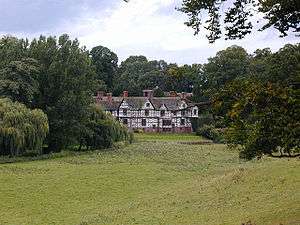Pitchford Hall



Pitchford Hall is a large Grade I listed Tudor country house in the village of Pitchford, Shropshire, 6 miles south east of Shrewsbury.
It was built c.1560 on the site of a medieval building and has been modified several times since, particularly in the 1870s and 1880s when it was substantially restored, remodelled and extended. It is a timber framed two-storey building with rendered red sandstone panels, a stone roof and brick chimneys. The floor plan is E-shaped round a courtyard to the south with a Victorian service wing to the west. There is also an Orangery and walled garden in the grounds.
A deer park established in 1638 was disparked in 1790. 100 metres north of the hall is a bitumen well, near a ford across the Row Brook, from which the village gets its name. The bitumen or pitch was once used for waterproofing the timbers of the house. A Tudor style tree-house sits in a large lime tree and is believed to be the oldest tree house in the world.
The Hall was sold by Caroline Colthurst, the owner of the Pitchford Estate, in 1992. It has, however, recently been reunited with the Pitchford Estate (28 September 2016) by Caroline's daughter, Rowena Colthurst and her husband James Nason.
A stretch of the Roman Watling Street runs through the Estate.
History
There has been a Manor House on the site since around 1284, the estate at the time being in the possession of the de Pykeford family. Geoffrey de Pykeford, a crusader, was Lord of the Manor from 1272 and built the local church of St Michael, which contains an oak effigy of him. Eventually, however, the family had to sell the estate to the Church in the 1330s in order to repay debts.
Thomas Ottley bought the Manor of Pitchford in 1473. The present house was built c.1560 for Adam Ottley, a Shrewsbury wool merchant, and possibly incorporated elements of the previous medieval structure. The estate remained in the Ottley family until the death of Adam Ottley in 1807. The hall and estate then passed to Hon. Charles C. C. Jenkinson, second son of the 1st Earl of Liverpool and later to his son-in-law John Cotes. John's son Charles Cotes commissioned the London architect George Devey to renovate and upgrade the house, which included the installation of replacement windows, baths and water closets. Charles died unmarried and the estate passed in 1918 to his brother-in-law Lieut-General Sir Robert Grant. Until 1992, the Colthurst family were in possession and carried out further restoration to the Hall under the guidance of English Heritage and Andrew Arrol.
The house was visited in 1832 by Princess (later Queen) Victoria, who watched a fox hunt from the treehouse, and wrote in her diary the hall was "A curious looking but very comfortable house. It is striped black and white, and in the shape of a cottage".[1]
Next century it was visited in 1935 by the Duke and Duchess of York (later King George VI and Queen Elizabeth). During the Second World War, Pitchford was one of the country retreats selected to house the Royal Family should they have needed to be evacuated from the capital (see Coats Mission).
The Hall is no longer open to the public but the new owners hope to re-open it to the public as soon as the Hall is restored. The Hall is currently on Historic England's Buildings at Risk Register. Pitchford Church (CofE), opposite the Hall, is open to the public and holds services once or twice a month.
A former Great Western Railway Hall class locomotive No 4953, now running on the Epping Ongar Railway, was named Pitchford Hall.
References
- ↑ "A Tribute of Caroline Colthurst of Pitchford Hall". Shropshire Life. Retrieved 26 April 2012.
- "A nice little place in the country". BBC- Shropshire. Retrieved 2012-11-06.
- "Pitchford Hall, Pitchford". British Listed Buildings. Retrieved 2012-11-06.
- "Pitchford estate". Retrieved 2012-11-06.
| Wikimedia Commons has media related to Pitchford Hall. |
Coordinates: 52°38′02″N 2°41′57″W / 52.6338°N 2.6991°W